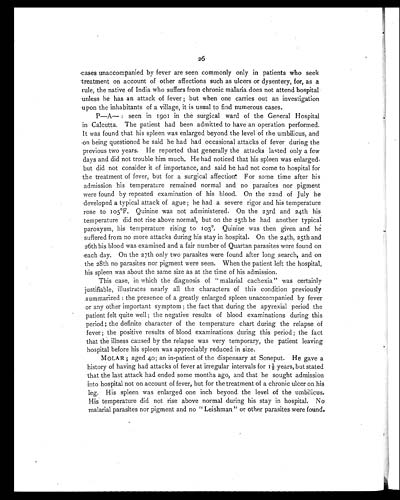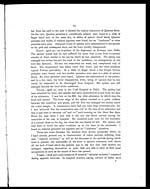Medicine - Institutions > Army health reports and medical documents > Scientific memoirs by officers of the Medical and Sanitary Departments of the Government of India > Number 19 - On kala azar, malaria and malarial cachexia > On kala azar, malaria and malarial cachexia
(34) Page 26
Download files
Individual page:
Thumbnail gallery: Grid view | List view

26
cases unaccompanied by fever are seen commonly only in patients who seek
treatment on account of other affections such as ulcers or dysentery, for, as a
rule, the native of India who suffers from chronic malaria does not attend hospital
unless he has an attack of fever; but when one carries out an investigation
upon the inhabitants of a village, it is usual to find numerous cases.
P—A—: seen in 1901 in the surgical ward of the General Hospital
in Calcutta. The patient had been admitted to have an operation performed.
It was found that his spleen was enlarged beyond the level of the umbilicus, and
on being questioned he said he had had occasional attacks of fever during the
previous two years. He reported that generally the attacks lasted only a few
days and did not trouble him much. He had noticed that his spleen was enlarged,
but did not consider it of importance, and said he had not come to hospital for
the treatment of fever, but for a surgical affection. For some time after his
admission his temperature remained normal and no parasites nor pigment
were found by repeated examination of his blood. On the 22nd of July he
developed a typical attack of ague; he had a severe rigor and his temperature
rose to 105°F. Quinine was not administered. On the 23rd and 24th his
temperature did not rise above normal, but on the 25th he had another typical
paroxysm, his temperature rising to 103°. Quinine was then given and he
suffered from no more attacks during his stay in hospital. On the 24th, 25th and
26th his blood was examined and a fair number of Quartan parasites were found on
each day. On the 27th only two parasites were found after long search, and on
the 28th no parasites nor pigment were seen. When the patient left the hospital,
his spleen was about the same size as at the time of his admission.
This case, in which the diagnosis of "malarial cachexia" was certainly
justifiable, illustrates nearly all the characters of this condition previously
summarized: the presence of a greatly enlarged spleen unaccompanied by fever
or any other important symptom; the fact that during the apyrexial period the
patient felt quite well; the negative results of blood examinations during this
period; the definite character of the temperature chart during the relapse of
fever; the positive results of blood examinations during this period; the fact
that the illness caused by the relapse was very temporary, the patient leaving
hospital before his spleen was appreciably reduced in size.
MOLAR; aged 40; an in-patient of the dispensary at Soneput. He gave a
history of having had attacks of fever at irregular intervals for 1½ years, but stated
that the last attack had ended some months ago, and that he sought admission
into hospital not on account of fever, but for the treatment of a chronic ulcer on his
leg. His spleen was enlarged one inch beyond the level of the umbilicus.
His temperature did not rise above normal during his stay in hospital. No
malarial parasites nor pigment and no "Leishman" or, other parasites were found.
Set display mode to: Large image | Zoom image | Transcription
Images and transcriptions on this page, including medium image downloads, may be used under the Creative Commons Attribution 4.0 International Licence unless otherwise stated. ![]()
| Permanent URL | https://digital.nls.uk/75027575 |
|---|
| Shelfmark | IP/QB.10 |
|---|---|
| Additional NLS resources: | |




